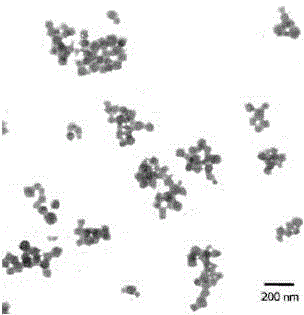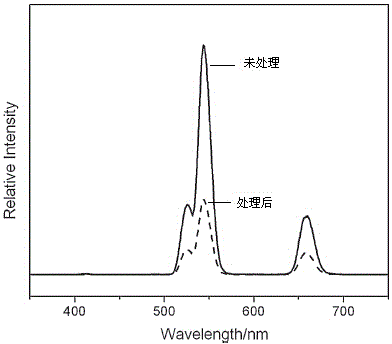Water-soluble up-conversion nanoparticles and preparation method thereof
A nanoparticle, water-soluble technology, applied in the field of nanomaterials, can solve the problems of limited application, poor water solubility and biocompatibility, and achieve the effects of high luminous intensity, good water solubility and good application prospects.
- Summary
- Abstract
- Description
- Claims
- Application Information
AI Technical Summary
Problems solved by technology
Method used
Image
Examples
Embodiment 1
[0025] 0.78mmol of Y (CF 3 COO) 3 , 0.2mmol of Yb (CF 3 COO) 3 , 0.02mmol of Er(CF 3 COO) 3 , 10mmol sodium fluoride (NaF) and 20ml organic solvent (10ml oleic acid OA + 10ml carbadecene ODE) were added to a 50mL three-necked flask and heated to 120°C, continuously fed with nitrogen protection and heated for 1h, then Raise the temperature to 320°C at a speed of 1°C / min and stir it magnetically for 1 hour, cool down to room temperature naturally, add absolute ethanol, centrifuge to obtain a precipitate, and then repeatedly wash with water and ethanol to finally obtain various Upconverting nanoparticles (UCNPs) in organic solvents.
[0026] Mix 1g / L of 5mL up-converting luminescent nanoparticles hexane dispersion solution with 0.6g / L of 5mL nitrosonium tetrafluoroborate NOBF 4The dichloromethane solution was mixed at room temperature, and the mixture was shaken gently until the UCNPs precipitated, then centrifuged, the supernatant was removed, and then redispersed in water...
Embodiment 2
[0029] 0.69mmol of Y (CF 3 COO) 3 , 0.3mmol of Yb (CF 3 COO) 3 , 0.01mmol of Er(CF 3 COO) 3 , 10mmol sodium fluoride (NaF) and 20ml organic solvent (10ml oleic acid OA + 10ml carbadecene ODE) were added to a 50mL three-necked flask and heated to 120°C, continuously fed with nitrogen protection and heated for 1h, then Raise the temperature to 320°C at a speed of 1°C / min and stir it magnetically for 1 hour, cool down to room temperature naturally, add absolute ethanol, centrifuge to obtain a precipitate, and then repeatedly wash with water and ethanol to finally obtain various Upconverting nanoparticles (UCNPs) in organic solvents.
[0030] Mix 2g / L of 5mL up-converting luminescent nanoparticles hexane dispersion solution with 0.3g / L of 5mL nitrosonium tetrafluoroborate NOBF 4 The dichloromethane solution was mixed at room temperature, and the mixture was shaken gently until the UCNPs precipitated, then centrifuged, the supernatant was removed, and then redispersed in wate...
Embodiment 3
[0032] 0.78mmol of Y (CF 3 COO) 3 , 0.2mmol of Yb (CF 3 COO) 3 , 0.02mmol of Tm (CF 3 COO) 3 , 10mmol sodium fluoride (NaF) and 20ml organic solvent (10ml oleic acid OA + 10ml carbadecene ODE) were added to a 50mL three-necked flask and heated to 120°C, continuously fed with nitrogen protection and heated for 1h, then Raise the temperature to 320°C at a speed of 1°C / min and stir it magnetically for 1 hour, cool down to room temperature naturally, add absolute ethanol, centrifuge to obtain a precipitate, and then repeatedly wash with water and ethanol to finally obtain various Upconverting nanoparticles (UCNPs) in organic solvents.
[0033] Mix 2g / L of 5mL up-converting luminescent nanoparticles hexane dispersion solution with 0.6g / L of 5mL nitrosonium tetrafluoroborate NOBF 4 The dichloromethane solution was mixed at room temperature, and the mixture was shaken gently until the UCNPs precipitated, then centrifuged, the supernatant was removed, and then redispersed in wat...
PUM
 Login to View More
Login to View More Abstract
Description
Claims
Application Information
 Login to View More
Login to View More - Generate Ideas
- Intellectual Property
- Life Sciences
- Materials
- Tech Scout
- Unparalleled Data Quality
- Higher Quality Content
- 60% Fewer Hallucinations
Browse by: Latest US Patents, China's latest patents, Technical Efficacy Thesaurus, Application Domain, Technology Topic, Popular Technical Reports.
© 2025 PatSnap. All rights reserved.Legal|Privacy policy|Modern Slavery Act Transparency Statement|Sitemap|About US| Contact US: help@patsnap.com


